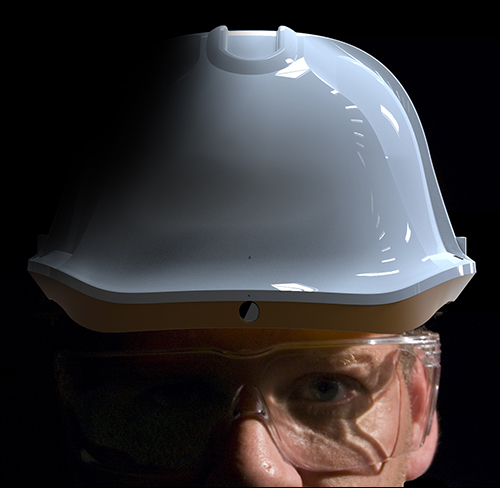Oct 02, 2017GuardHat, an Internet of Things (IoT) technology startup, has launched a system to monitor the locations of workers, as well as detect if they may be entering or exposed to dangerous conditions, via sensors on their hard hats. The system uses GuardHat's wireless sensor-based technology, built into a hard hat, in addition to beacon devices with multiple communication technologies built in, as well as its sensor data management software, integrated with a data-analytics software platform from HPCC Systems.
HPCC Systems, an open-source, big data platform originally developed by LexisNexis Risk Solutions, offers a workflow processing and analytics platform known as Thor, along with a real-time data-delivery platform dubbed ROXIE. That software, combined with GuardHat's own IoT system, enables users to view, both in real time and historically, data related to the location and status of employees around worksites. The system is currently being tested by three oil and gas companies in North America and Europe, says Gerrit Reepmeyer, GuardHat's co-founder and chief operating officer, while several metal and mining operations are preparing to deploy their own tests of the technology as well.

GuardHat was launched in late 2014 by a team of individuals from the steel industry. They had not only worked in industrial environments, but had witnessed the lack of visibility with which management struggled when it came to worker safety and employee management. Reepmeyer recalls that one of the founders had witnessed a night-shift incident during which a worker caused and detected but failed to report a carbon monoxide leak, which could have created a hazard for personnel.
The GuardHat system is designed to take the guesswork out of managing workers. Its built-in sensors are intended to track where employees are located, any gasses to which they might have been exposed, if they enter an unauthorized area and multiple other safety or efficiency concerns.
Each GuardHat is manufactured to meet the same requirements of any standard worker-safety hat, but the GuardHat has intelligence built in, the company reports—it comes with a variety of sensors to help identify each worker's location with up to 1-meter accuracy. The system also includes an RFID reader to detect the proximity of a hard hat from a tagged item. It comes with sensors, such as a gas detector and an accelerometer to identify movement, even if a worker suddenly falls, as well as a camera and a microphone.
The hard hat has three buttons on it: two to control audio and video, and a third to issue an SOS message. In the case of the audio function, a worker can simply press the corresponding button and the microphone will enable him or her to speak with someone—a manager, for instance—remotely using a Wi-Fi or cellular connection. If the employee presses the video button, the camera on the hard hat will enable that person to share video footage of what he or she is doing, such as inspecting a device or conducting a repair. In that way, employees can accomplish audio and visual conversations with those who might be technical experts related to the work being done. The SOS button allows an individual to request emergency help, and the GuardHat can send that request via a Wi-Fi or cellular network.
For management, the GuardHat provides a variety of functions. With regard to worker location, managers can open the Web dashboard to view where workers are located, indicated as dynamic points of interest on a display of the area map. GuardHat's wireless beacon devices installed around a facility enable a particular hard hat to be located via a combination of all geo-location technologies.
The HPCC Systems software identifies actionable information, such as detecting a dangerous situation—for instance, the presence of gas or chemicals—and can raise an alarm accordingly. The system can also evaluate the relevance of the sensor and location data; for example, a single GuardHat sensor reporting could be an anomaly, but multiple responses from hard hats in the area would require immediate alerts.

"The system is very customizable," says Flavio Villanustre, LexisNexis Risk Solutions' VP of technology and the head of HPCC Systems. "Supervisors can get an alert" in the event that they wish to know immediately if an unauthorized activity occurs, such as an individual entering an area where he or she is not permitted. Alternatively, they can program the system to simply collect information for historic reference, transmit a text message, or display visual and audio alerts on the hard hats themselves. The solution can be hosted in the cloud, or be integrated on a user's back-end system.
Users can leverage historical data from the Thor software platform to view the movements of workers over time, and to better manage workflow accordingly, in order to improve efficiency on a worksite. The technology also works in a lone worker scenario, such as a single employee in a remote area—for instance, driving around a well for the purpose of condition inspection. In this case, the system can utilize a local Wi-Fi network, such as a system installed on a vehicle, or a cellular connection to forward data regarding that individual's movements and nearby conditions.
"At the end of the day, the hard hat is just a device," Reepmeyer says, while building the intelligence from its own sensor software and the HPCC Systems platform makes the collected data actionable. The company founders' experience in the steel industry, he adds, has resulted in an intuitive product that solves problems in the field or at production sites without unnecessary, high-priced technology that other companies might develop. The firm expects most customers to initially deploy the technology to boost safety, while the operational efficiency that could result might be the next step in their deployment.
Reepmeyer expects users themselves (workers in industrial environments) to adapt to the technology organically. "You see everyone in a plant already using devices," he states—not only smartphones, but exercise systems counting steps, for instance. Now, the GuardHat system will provide workers with improved safety, he says.
Once testing is completed, Reepmeyer reports, GuardHat intends to roll out its solution commercially, sometime in mid-2018.

